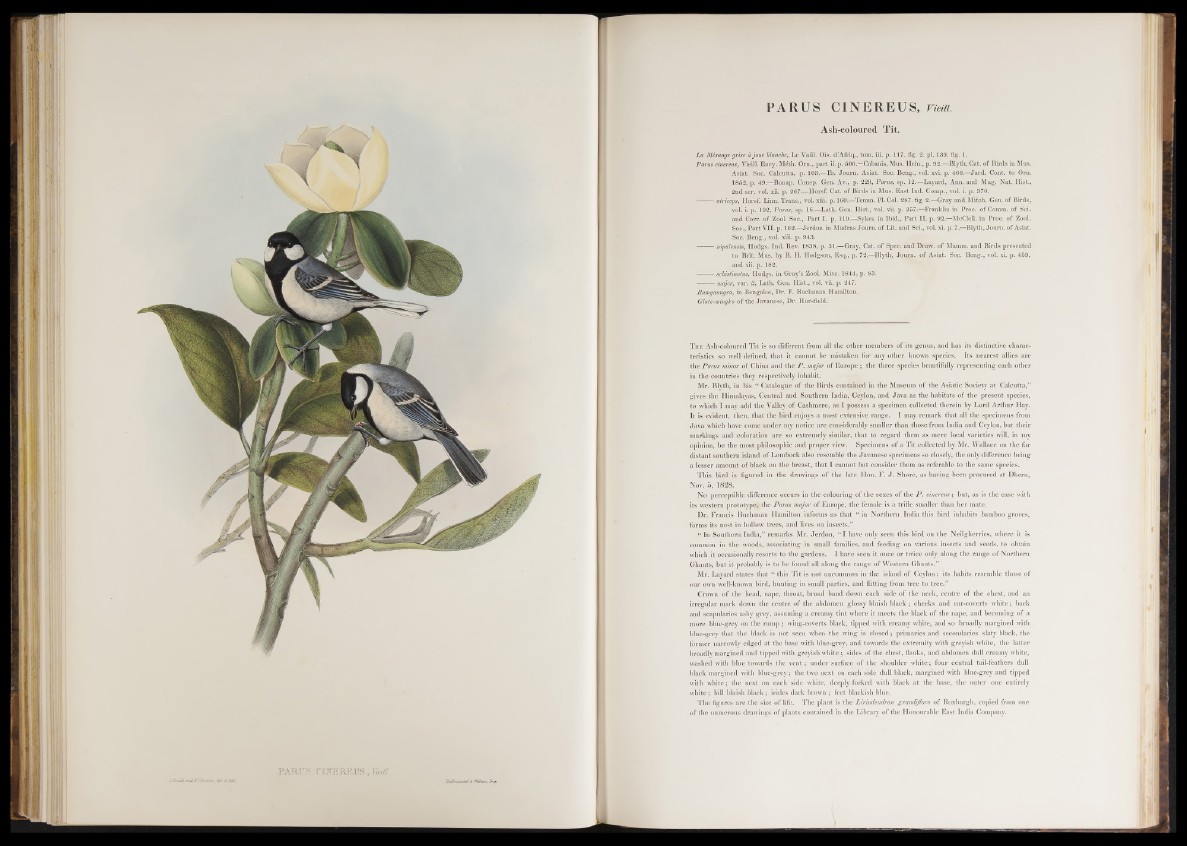
PARUS. CIÎOEREUS, YmU.
P A R U S C I N E R E U S , Vieüi.
Ash-coloured Tit.
La Mésange grise à joue blanche, Le Vaill. Ois. d’Afriq., tom. iii. p. 117. fig. 2. pl. 139. fig. 1.
Parus cinereus, Vieill. Ency. Méth. Orn., part ii. p. 506.—Cabanis, Mus. Hein., p. 92.—Blyth, Cat. of Birds in Mus.
Asiat. Soc. Calcutta, p. 103.—lb. Journ. Asiat. Soc. Beng., vol. xvi. p. 466.—Jard. Cont. to Ora.
1852, p. 49.—Bonap. Consp. Gen. Av., p. 229, Parus, sp. 12.—Layard, Ann. and Mag. Nat. Hist.,
2nd ser. vol. jrii. p. 267.—Horsf. Cat. of Birds in Mus. East Ind. Comp., vol. i. p. 370.
atriceps, Horsf. Linn. Trans., voL xiii. p. 160.—Temm. PI. Col. 287. fig. 2.—Gray and Mifch. Gen. of Birds,
vol. i. p. 192, Parus, sp. 16.—Lath. Gen. Hist., vol. vii. p. 257.—Franklin in Proc. of Comm, of Sci.
and Coit. of Zool. Soc., Part I. p. 119.—Sykes in Ibid., Part II. p. 92.—McClell. in Proc. of Zool.
Soc., P art VII. p. 162.—Jerdon in Madras Joum. of Lit. and Sci., vol.xi. p. 7.—Blyth, Journ. of Asiat.
Soc. Beng., vol. xiii. p. 943.
nipalensis, Hodgs. Ind. Rev. 1838, p. 31.—Gray, Cat. of Spec, and Draw, of Mamm. and Birds presented
to Brit. Mus. by B. H. Hodgson, Esq., p. 72.—Blyth, Joum. of Asiat. Soc. Beng., vol. xi. p. 459,
and xii. p. 182.
schistinotus, Hodgs. in Gray’s Zool. Misc. 1844, p. 83.
major, var. /3, Lath. Gen. Hist., vol. vii. p. 247.
Ramgaungra, in Bengalee, Dr. F. Buchanan Hamilton.
Glate-winglco of the Javanese, Dr. Horsfield.
T h e Ash-coloured T it is so different from all the other members of its genus, and has its distinctive characteristics
so well defined, that it cannot be mistaken for any other known species. Its nearest allies are
the Pants minor of China and the P . major of Europe j the three species beautifully representing each other
in the countries they respectively inhabit.
Mr. Blyth, in his “ Catalogue of the Birds contained in the Museum o f the Asiatic Society a t Calcutta,”
gives the Himalayas, Central and Southern India, Ceylon, and Java as the habitats o f the present species,
to which I may add the Valley of Cashmere, as I possess a specimen collected therein by Lord Arthur Hay.
It is evident, then, that the bird enjoys a most extensive range. I may remark that all the specimens from
Java which have come under my notice are considerably smaller than those from India and Ceylon, but their
markings and coloration are so extremely similar, that to regard them as mere local varieties will, in my
opinion, be the most philosophic and proper view. Specimens of a Tit collected by Mr. Wallace on the far
distant southern island of Lombock also resemble the Javanese specimens so closely, the only difference being
a lesser amount of black on the breast, that I cannot but consider them as referable to the same species.
This bird is figured in the drawings o f the late Hon. F. J . Shore, as having been procured a t Dheru,
Nov. 5, 1828.
No perceptible difference occurs in the colouring of the sexes of the P . cinereus; but, as is the case with
its western prototype, the Parus major o f Europe, the female is a trifle smaller than her mate.
Dr. Francis Buchanan Hamilton informs us that “ in Northern India this bird inhabits bamboo groves,
forms its nest in hollow trees, and lives on insects.”
■ ‘ In Southern India,” remarks Mr. Jerdon, “ I have only seen this bird on the Neilgherries, where it is
common in the woods, associating in small families, and feeding on various insects and seeds, to obtain
which it occasionally resorts to the gardens. I have seen it once or twice only along the range o f Northern
Ghauts, but it probably is to be found all along the range of Western Ghauts.”
Mr. Layard states that “ this T it is not uncommon in the island of Ceylon; its habits resemble those of
our own well-known bird, hunting in small parties, and flitting from tree to tree.”
Crown o f the head, nape, throat, broad band down each side of the neck, centre of the chest, and an
irregular mark down the centre of the abdomen glossy bluish black; cheeks and ear-coverts white; back
and scapularies ashy grey, assuming a creamy tint where it meets the black of the nape, and becoming of a
more blue-grey on the rump ; wing-coverts black, tipped with creamy white, and so broadly margined with
blue-grey that the black is not seen when the wing is closed; primaries and secondaries slaty black, the
former narrowly edged at the base with blue-grey, and towards the extremity with greyish white, the latter
broadly margined and tipped with greyish white ; sides of the chest, flanks, and abdomen dull creamy white,
washed with blue towards the v e n t; under surface o f the shoulder white; four central tail-feathers dull
black margined with blue-grey; the two next on each side dull black, margined with blue-grey and tipped
with white; the next on each side white, deeply forked with black at the base, the outer one entirely
white; bill bluish black; irides dark brown ; feet blackish blue.
The figures are the size of life. The plant is the Liriodendron grandiflora of Roxburgh, copied from one
of the numerous drawings of plants contained in the Library of the Honourable East India Company.